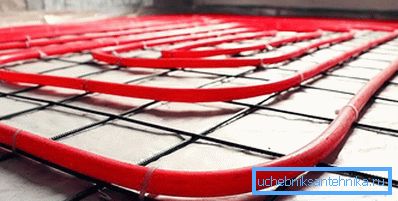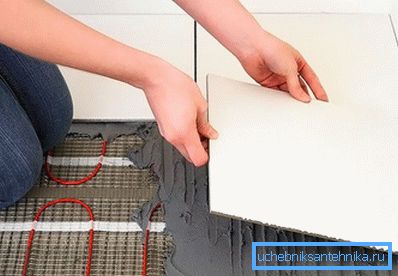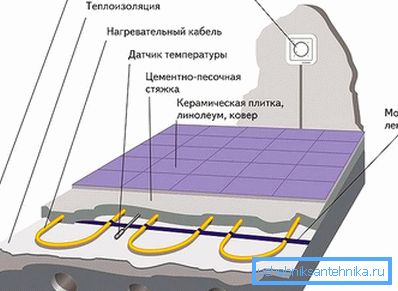How to lay a warm floor under the tile
The tile is a floor covering possessing a number of undoubted consumer properties:
- absolute moisture resistance - does not collapse from exposure to water;
- resistance to most organic and inorganic detergents;
- has strength to static loads;
- service life of 20-50 years.
But the surface, made of ceramic coating, causes a feeling of cold when touched. This is explained by the fact that this material has a large coefficient of heat absorption. That is, the tile "pulls" the heat, takes it from the human body. You can fix this negative factor by understanding how to lay a warm floor under the tile.
Special features

The generalized concept of "warm floor" is a design of a number of nodes, parts through which the transfer of thermal energy to the tile. Two main types of thermal devices are developed and applied:
- The water heat-insulated floor - represents the closed system of water pipes on which circulation of the heat carrier is carried out. Hot water comes from the general water supply system or from a separate heating device.
- Electric heating design - it is based on a system of heat-generating electrical wires or plates.
Water system

The process of installing underfloor water heating is carried out under an additional concrete screed, on the surface of which a tiled floor is subsequently arranged.
Stages of work:
- The base is cleared of debris, mud deposits.
- Layed layers of hydro and thermal insulation.
- Mounted pipe system. It is best to use metal-plastic products - they are plastic, due to which they can bend around various curvilinear formations. Propylene pipes have advantages over traditional iron pipes in that they do not produce smoke and dirt.
- The concrete screed is laid. It is necessary to ensure that it contains plasticizers to make it more plastic.
- Next is laying tile floor.
The advantages of a water system are that it has a significantly lower consumption of additional heat - the carrier comes from the centralized hot heating system. However, its installation is more complicated than the installation of electrical devices.
It should be remembered that the input and output coolant will have a different temperature. From here follow two conclusions:
- water floor should be used on an area limited by the size of 2-10 m ?;
- with significant heated surfaces, it is necessary to carefully work out the location of the pipes in order to create a uniform thermal field.
Electric floor heating

A heating device based on electrical energy is a system consisting of:
- fuel element in the form of a cable, plate or film;
- external power wires;
- thermostat - sensor that fixes the temperature of heating.
How to make the kitchen or in the hallway have a warm surface of the floor, and at the same time simplify installation work? To do this, it is necessary to choose the design of the heating unit.

The simplest device is a fuel cable. But for its installation will require some additional work:
- careful marking of the surface;
- correct cable layout;
- fixing the wire to the base.
The mesh construction is more convenient in this respect - the electrical cable is mounted on a fiberglass mesh and is a mat, carpet or walkway.
The sequence of installation work:
- Removed debris, dirt.
- The laying of the heated floor is carried out according to a previously prepared scheme. Remember that in the locations of heavy furniture electrical system can not be laid.
- Thermal insulation material is spread. In this case, the foiled layer should face the heating structure.
- In accordance with the manufacturer's recommendations, an electric flooring device is provided. A preliminary check of the operation of all nodes.
- The tile is laid. A special tile adhesive is used to work with heating systems.
- After 3–7 days, the electrical system is adjusted to the required output parameters.

If we compare the electric floor heating and water heating, then the complexity and time of the device, the latter loses the electrical system. From the economic point of view, a water floor heating system is more profitable.
Video
From the provided video you can find out the details of creating a warm floor under the tile: